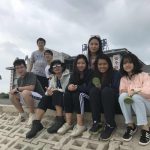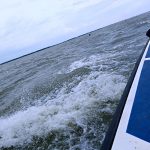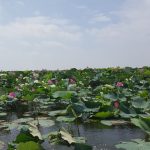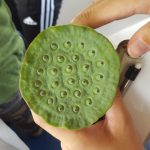Blog Entry Written By Team: Golden Rod
Team Members: Ernest Hon-Hin Yeung (Queen’s), Mengze Zhang (Waterloo)
Weather: Cloudy, windy with a few rain drops in the afternoon at the conservation site
Today was our 4th day of our field course. In the morning Professor Lougheed gave us a lecture about avian diversity and conservation. The lecture included characteristics of birds, origins of the vertebrate class, and mono-phyly of birds. The most memorable and interesting part for the lecture was discussion of the discovery of a kind of feathered dinosaurs, Yutyrannus huali, found in fossil beds of Liaoning Province, China. The professor also explained how scientists have used the technology related to detecting fossilised evidence of the cells that produce pigments (melanin) to quantify patterns of the plumage of some fossil birds. Last but not least, Steve also mentioned the importance of birds to human society and that the diversity of birds found in wetlands could help us identify the health of ecosystems.
After the lecture, we departed for Hong Hu natural reserve area and had our lunch at one of the local hotels near the reserve. The theme of the dishes was on local ingredients , like fish and lotus. It was by far one of the best meals we’ve had on this trip.
We finally arrived at the reserve in the afternoon, where we were invited to board a motorboat, so that we could evaluate the progress and effectiveness of the conservation program to the ecosystem in the lake. The lake has many interesting aquatic organisms like wild water chestnut (Eleocharis dulcis), wild lotus (Nelumbo nucifera) and many terns (Family: Sterninae), just some of the species that the government is trying to protect. In Hong Hu, there are about 40km2 of wild lotus in the reserve and we could see different kind of birds inhabiting the lotus (e.g. little egret, Egretta garzetta), showing the diversity of ecosystem in the reserve and the ability of lotus in enhancing water quality. The class took myriad beautiful pictures during out tour. The section head f the project and our host, Mr. Dung provided us with some basic information on the reserve. The total area of the conservation area is about 162km2 and was once famous for commercial fishing. In 2005, the government proposed a regulation on fishing in the area, only allowing each family to keep 0.1 km2 of pens to raise fish. In 2016, all fishing activities in the reserve were banned and all fishing in the area has now been removed. This of course resulted in a need to address the problem of how to replace lost income for fishers. Originally, they had all lived on boats and received their income through fishing. Their children had no formal education as schools were simply not accessible. It has become a challenge for some now that they have moved to the city or have tried to find other jobs because they lack the necessary skills. Currently, the Chinese government is providing education, training, job, social welfare and a house to those who have been affected. However, these agreements could not solve all the problems that arose. Some fishers may not be able to adapt to such a new environment, and subsidies provided by the government may be insufficient in the long term.
This has led to a debate on whether we should put more consideration toward human well-being or environmental health. In our own opinion, we should probable put more consideration on the environmental side, because environmental conservation and restoration is a long-term process and is necessary for human well-being. If one thinks about the “Tragedy of the Commons” (a term invented by American ecologist Garret Harding), if the government does not interfere, people will not have the incentive or interest to protect the environment, which would ultimately lead to degradation. People will no longer be able to harvest any quality resources from such degraded ecosystems and this would possibly lead to more substantive impacts for the society compared to the ban announced by the government.
Through toady’s investigation and study, we have learned that China have moved forward on natural ecosystem conservation, putting more attention and resources into this domain. The proposed solutions and conservation plans achieving some success. There is always controversy in different environmental projects and stakeholders must work together to obtain the best results.
今天是课程进行的第四天。上午在宾馆的会议厅由 Stephen 教授给我們讲了水生鸟类的多样性和保育。课程中讲了所有鸟类的都具有的特点,鸟类的来源,共源性状。还有一点令我印象深刻的就是在中国发现了一种带羽毛的恐龙,体型比人类大很多,并且Steven教授还解释了科学家们用色谱沉着技术确定恐龙的羽毛颜色。之后还讲了鸟与人类的关系,鸟的数量和种类可以反映出当地生态环境的情况。
讲座结束后我们乘坐大巴车前往洪湖保护区考察。途径一家酒店,在那里吃了午饭,基本上全是鱼,算是目前最像样子的一顿饭吧。
下午到达目的地后我们很幸运坐上游艇参观洪湖的治理成果。湖中有许多野生荷花,野生荷花(Nelumbo nucifera), 野生荸荠(Eleocharis dulcis)和燕鷗(Sterninae)都是国家重点保护植物,洪湖有近万亩的荷花淀,有许多水生鸟类栖息在荷花淀中,比如白鹭(Egretta garzetta)。这也说明了洪湖的环境治理是有一定效果的。我们在荷花丛中拍照,因为景色真的很美。在游艇上,当地的负责人鄧先生给我们介绍洪湖一共四万多亩,以养鱼著称,但是湖都是被渔民用渔网围起来分隔开。在2005年的时候开始逐渐的拆除围网,在2016年的时候所有的围网被拆完。但是围网拆完后渔民的生活问题就出现了,这些渔民就是生活在船上,靠养鱼维生,而且他们的孩子也不上学,如何让他们融入社会成了一项挑战。目前政府采取的措施是提供免费的教学,教他们一项技能,还有提供一些岗位,比如参与到保护生态的活动中来。每一家都有安家费,保证每一户都有一个人拥有一份工作。虽然这样看上来政府做的很周到,考虑的也很全面,但是有很多渔民并不能真正的适应新的环境,他们已经在渔船上生活了很多年让他们突然改变生活方式真的很困难,有很多人之后都是靠在城市中捡垃圾为生,几十万的安家费在如今的房价面前也是杯水车薪。
所以一个问题出现了,这样为了改变生态环境而牺牲近两万户渔民的生活对不对,我个人感觉是对的。因为生态环境保护是一个持久的过程,也是一项必须要进行的活动,这个活动将会造福数百万人,而且对这些渔民们的子女也是有利的,我们一直在强调可持续发展,所以牺牲一小部分人的利益而造福更多的人,是一项明智的决定。世上没有绝对完美的事情,我们能做的就是实现利益最大化。
通过今天的调查,我了解到生态环境问题已经引起了国家的重视,而且治理也取得了一定的结果。而且非常重要的是生态环境的保护需要很多群体参与其中,包括政府,生活在当地的百姓,学者,教授,投资方一起相互协调才能完成这件事情。
- Fig. 5 One of the group picture we took at the pier. 我們在碼頭拍的一張團體照
- Fig. We were having our lunch. 我們在一富享用午餐.
- Fig 6. The surface of HongHu. 洪湖的水面.
- Fig. 2. This the lotus field located a the center of the HongHu conservation area.我們在洪湖保護區看到的一片蓮花林.
- Fig. 1. This is the lotus seen given to us by local lotus harvesters. 這蓮蓬是當地採蓮人給我們的.
- Fig. 3 Local lotus harvesters made a hat with lotus and flower and gave it to Sasha as a gift. 當地採蓮人用荷花和荷葉做子一頂帽子送給 Sasha.
- Fig. 7 Whiskered tern flying over patches of lotus.







Leave a Reply